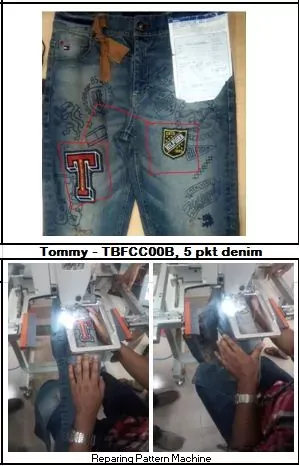Industrial Engineering (IE) in Garment Industry
Industrial Engineering:
Garment manufacturing industry faces many global challenges due to various factors including less CM, competition, increased production costs, less productivity/efficiency and labor attribution. So, there is a need to focus and concentrate on identifying the real issues, taking corrective actions according to that. Starting a career in IE department is not very easy, there is a challenge too and pressure to fill up the production target of assigned sewing lines. Industrial Engineering is manufacturing engineering to increase productivity and quality. Industrial engineering basically relates to the effective use of man, machines and material during the production process.
Why Industrial Engineering is Need in Apparel Industry?:
Industrial engineers determine the most effective ways for an organization to use the basic factors of production - people, machines, materials, information, and energy - to make or process a product or produce a service. They are the bridge between management goals and operational performance. They are more concerned with increasing productivity through the management of people, methods of business organization, and technology than are engineers in other specialties, who generally work more with products or processes.
·
Study
the product and its requirements
·
Use
mathematical methods to meet product requirements
·
Production
planning and cost analysis
·
Capacity
analysis, Line balancing, Calculate NPT, Bottleneck removing, etc
·
Analyze
CM, SMV, costing, consumption, profit- Loss.
· Follow up daily production target and production achievement.
Responsibilities of
IE:
· Ensure Operation Bulletin (OB) and re-engineering or balancing the bulletin for better productivity in sewing and finishing
· Measuring accurate factory efficiency, line performance, changeover effectiveness, capacity study, time & motion study, machine breakdown, etc.
· Supply the costing SMV information to merchandising team for costing purpose. Pre-order costing and post order costing in coordination with the merchandising team.
· Set up base targets based on basic, semi-critical & critical operations and ensure the implementation of line and special incentive policy.
· Optimum of utilization Man, Machine & Method.
· Communicate with the sample section to make the product feasible for production,
· Prepare monthly manpower projection, requirement
· Ensure cost reduction by reducing all kinds of wastage.
· Implement industrial engineering practice in every possible area for maximum productivity and ensure optimum utilization of resources & implementation.
· Studying and implementing time study, method study, Bottleneck solving, Line Balancing Etc. Make line balancing according to target and capacity study during 2 – 3 days of layout. Find out the bottleneck process and solve it. If needed make 1-hour production study in the required process
· SMV (Standard Minutes Value), Efficiency calculation and assigned a Target based on efficiency and SMV.
· Give daily production target and follow up production achievement
· Everyday input and output monitoring
· Hourly production follow-up
· Collect the line loading plan from the Planning Department. Monitoring Production Schedule
· Collect the PP sample and make an operation bulletin accordingly.
· Collect Operation Bulletin and make a paper layout. Making Layout the machine with manpower distribution by maintaining proper sequence of sewing operations to ensure best workflow and 60%-70% efficiency.
· Discuss with Technician and Maintenance in-charge regarding the machine, folder, attachment, and Technical personnel for technical issues.
· Three days before the style starts in line, layout should be discussed with Factory Manager and Production Manager and get their signature to implement. If any changes in the layout is done, it must be updated and change accordingly with the approval of IE Department Head.
· Thread consumption. Cross-check thread consumption for every new style.
· Operators motion development by correcting faulty motion. Improve performance (Motivate).
· Set up and manage the Training Center for trainee operators, cooperate with HR for skill tests in recruitment, manage the skill assessment scheme for all production operators. Prepare skill inventory for the operator.
· KPI report, follow up and yearly presentation
· To monitor Target Vs Achievement KPI.
· To Make Reconciliation After Delivery of Every Shipment for The Illustration of Every Shipment According to File, PO, Style & Color.
You Might Find Useful Related to Industrial Engineering:
- 24 Effective Ways to Improve Productivity in Garment Production.
- Productivity Improve in Garments Industry.
- What is Assort Called in Garment Industry?
- Technical audit in the garment industry.
- What is sewing needle in the garment industry?
- What is 5S in the garment industry?
- What is garment sample in garments Factory?
- Difference between TQM and QMS.
- How to solve bottleneck problem in the Garment Industry?
- Productivity improvement factors in garment industries.
- Various Types of Industrial Sewing Machines.
- What is operation breakdown in the garment industry?
- How to calculate productivity in the garments?
Conclusion:
This concept of Industrial Engineering is a key to Garment industry to
improve their work nature and the methods. To survive in this
competitive world the industry should work more efficiently.

.webp)


It will be helpful for A learner. Thanks to sharing this.
ReplyDeleteHi. Shorab, I have read your blog on Industrial Engineering. It will help the IE. Please keep it good writing.
ReplyDeleteNice Blog
ReplyDeleteNice Blog
ReplyDeleteAwesome. Helpful post to learn about IE
ReplyDeleteNice
ReplyDelete